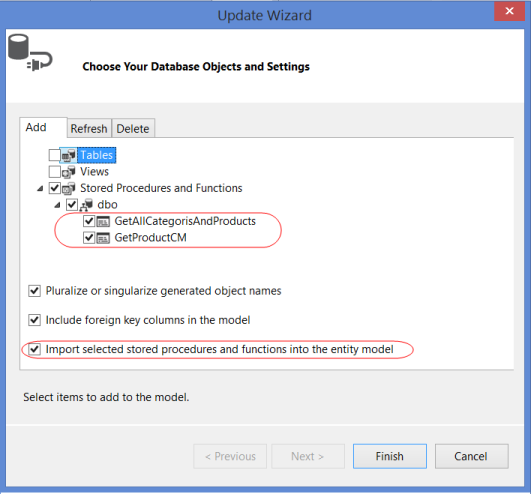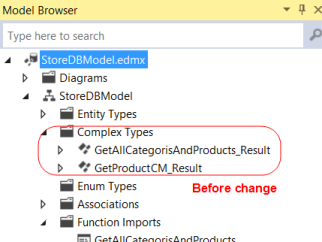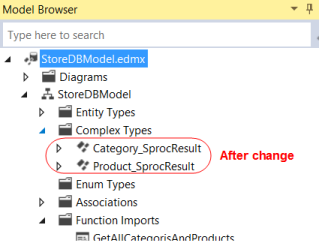EF6调用存储过程,返回多个结果集处理
链接:http://www.codeproject.com/Articles/675933/Returning-Multiple-Result-Sets-from-an-Entity-Fram
案例:下载
Create Visual Studio Project with Entity Data Model
Details to create an entity database-first app project are described in the MSDN tutorial. Follow the steps for building the app except using the sample database described above, the StoreDBModel for the model name, and the StoreDBEntities for the database connection string name.
Add Stored Procedures into the Entity Data Model



<FunctionImport Name="GetAllCategorisAndProducts" ReturnType="Collection(StoreDBModel.Category_SprocResult)" />
<FunctionImport Name="GetProductsCM" ReturnType="Collection(StoreDBModel.Product_SprocResult)" />
Change the code in the first FunctionImport node as shown below. This is actually to merge the second return type into the first FunctionImport node. The Type attribute in the second ReturnType node can easily be copied from the second FunctionImport node. After the merging, just leave the second FunctionImportnode there as it will automatically be deleted when we do the clean-up from the Model Browser later.
<FunctionImport Name="GetAllCategorisAndProducts">
<ReturnType Type="Collection(StoreDBModel.Category_SprocResult)" />
<ReturnType Type="Collection(StoreDBModel.Product_SprocResult)" />
</FunctionImport>
<FunctionImport Name="GetProductCM"
ReturnType="Collection(StoreDBModel.Product_SprocResult)" />
<FunctionImportMapping FunctionImportName="GetAllCategorisAndProducts"
FunctionName="StoreDBModel.Store.GetAllCategorisAndProducts">
<ResultMapping>
<ComplexTypeMapping TypeName="StoreDBModel.Category_SprocResult">
<ScalarProperty Name="CategoryID" ColumnName="CategoryID" />
<ScalarProperty Name="CategoryName" ColumnName="CategoryName" />
<ScalarProperty Name="ProductCount" ColumnName="ProductCount" />
</ComplexTypeMapping>
</ResultMapping>
</FunctionImportMapping>
<FunctionImportMapping FunctionImportName="GetProductCM" FunctionName="StoreDBModel.Store.GetProductCM">
<ResultMapping>
<ComplexTypeMapping TypeName="StoreDBModel.Product_SprocResult">
<ScalarProperty Name="ProductID" ColumnName="ProductID" />
<ScalarProperty Name="ProductName" ColumnName="ProductName" />
<ScalarProperty Name="CategoryID" ColumnName="CategoryID" />
<ScalarProperty Name="StatusCode" ColumnName="StatusCode" />
<ScalarProperty Name="StatusDescription" ColumnName="StatusDescription" />
<ScalarProperty Name="UnitPrice" ColumnName="UnitPrice" />
<ScalarProperty Name="AuditTime" ColumnName="AuditTime" />
</ComplexTypeMapping>
</ResultMapping>
</FunctionImportMapping>
Add the ResultMapping node from the second FunctionImportMapping into the firstFunctionImportMapping. Leave the entire second FunctionImportMapping node there for now.
<FunctionImportMapping FunctionImportName="GetAllCategorisAndProducts"
FunctionName="StoreDBModel.Store.GetAllCategorisAndProducts">
<ResultMapping>
<ComplexTypeMapping TypeName="StoreDBModel.Category_SprocResult">
<ScalarProperty Name="CategoryID" ColumnName="CategoryID" />
<ScalarProperty Name="CategoryName" ColumnName="CategoryName" />
<ScalarProperty Name="ProductCount" ColumnName="ProductCount" />
</ComplexTypeMapping>
</ResultMapping>
<ResultMapping>
<ComplexTypeMapping TypeName="StoreDBModel.Product_SprocResult">
<ScalarProperty Name="ProductID" ColumnName="ProductID" />
<ScalarProperty Name="ProductName" ColumnName="ProductName" />
<ScalarProperty Name="CategoryID" ColumnName="CategoryID" />
<ScalarProperty Name="StatusCode" ColumnName="StatusCode" />
<ScalarProperty Name="StatusDescription" ColumnName="StatusDescription" />
<ScalarProperty Name="UnitPrice" ColumnName="UnitPrice" />
<ScalarProperty Name="AuditTime" ColumnName="AuditTime" />
</ComplexTypeMapping>
</ResultMapping>
</FunctionImportMapping>
<FunctionImportMapping...>
. . .
</FunctionImportMapping>

- Open the EF designer by clicking the StoreDBModel.edmx file on the Solution Explorer. Then right-click any blank area on the designer and select the Update Model from Database…. This will open the Update Wizard window.
- Select the two stored procedures from the Stored Procedures and Functions list in the Add tab. Make sure that the Import selected stored procedures and functions into the entity model is checked and then click the Finish button. This will automatically add the function import mappings and the complex types for the stored procedures.
- Right-click any blank area on the EF designer and select the Model Browser. In the Model Browser, change the Complex Type name
GetAllCategorisAndProducts_ResulttoCategory_SprocResult, and theGetProductCM_ResulttoProduct_SprocResultas shown below. - Save the StoreDBModel.edmx file. The two complex type objects are created with the names we changed. Now we need to manually edit the XML content of the StoreDBModel.edmx file. Right-clicking the file, select the Open With…, and then XML (Text) Editor. Find the
FunctionImportnodes under theedmx:ConceptualModelsnode: - Find the
FunctionImportMappingnodes under theedmx:Mappings/../En<FunctionImportMappingnode. - Clean up dummy stored procedure settings by opening the Model Browser again. Delete the
GetProductCMin both Stored Procedures/Functions and Function Import lists. This will automatically delete all settings for theGetProductCMstored procedure mappings and also the method to call the dummy stored procedure in the StoreDBModel.Context.cs file. - Save the StoreDBModel.edmx file. All changes in settings and clean-up will then be in effect.
What Happen When Updating Model
Will the manual editing for returning multiple result sets from the stored procedure be overwritten when updating the model due to any database schema changes? Based on results of my tests using the Visual Studio 2013, all the editing changes were kept intact when adding entities or other stored procedures into, or deleting any items from, the model except for deleting or refreshing the edited stored procedure mappings.
When adding or changing the input/output parameters in the stored procedure, the updates will automatically be refreshed in the model if executing the Refresh tab from the Update Model from Database (Update Wizard) screen. For example, adding @as an input parameter to the stored procedure,Test nvarchar(50)GetAllCategorisAndProducts, in the database then refreshing the model will insert the Parameter node into the stored procedure’s FunctionImport node even though it was manually edited before.
<FunctionImport Name="GetAllCategorisAndProducts">
<ReturnType Type="Collection(StoreDBModel.Category_SprocResult)" />
<ReturnType Type="Collection(StoreDBModel.Product_SprocResult)" />
<Parameter Name="Test" Mode="In" Type="String" />
</FunctionImport>
Automatic refreshing stored procedure complex type mappings due to changes in returning fields is not supported in any version of the EF, even for a stored procedure returning a single result set. We need to either re-add the stored procedure to the model after dropping the stored procedure and function import mappings from the model, or manually update the complex type using the Model Browser or the XML editor.
EF6调用存储过程,返回多个结果集处理的更多相关文章
- myabatis oracle 调用存储过程返回list结果集
Mapper.xml 配置 <resultMap type="emp" id="empMap"> <id property="emp ...
- PostgreSQL 调用存储过程返回结果集
创建返回结果集类型的存储过程: CREATE OR REPLACE FUNCTION public.f_get_member_info( id integer, productname charact ...
- jdbc调用存储过程获取多个结果集
jdbc调用存储过程获取多个结果集 2017年07月26日 21:20:22 Kenny-Liu 阅读数:1486 版权声明:本文为博主原创文章,未经博主允许不得转载. https://blog.cs ...
- Java 调用存储过程 返回结果集
这里使用Oracle数据库的thin连接. 下面是存储过程SQL 1 createorreplaceprocedure proc3(stid in student.stuid%type, stname ...
- mybatis 调用存储过程 返回游标 实例
存储过程示例: create or replace procedure Fsp_Plan_CheckPrj(v_grantno varchar2, v_deptcode number, v_curso ...
- sqlserver,获取调用存储过程返回数据的方法。
1,获取存储过程最后select返回的结果集.SELECT 数据集返回值. 因为select返回的结果是一个表.所以返回的结果需要用一个表接收.使用临时表接收. 被调用的存储过程最后是这样:返回了一个 ...
- 整理sqlserver 级联更新和删除 c#调用存储过程返回值
整理一下级联更新和删除 c#调用返回值 use master go IF exists(select 1 from sysdatabases where name='temp') BEGIN DROP ...
- java调用oracle存储过程返回多条结果集
oracle版本:11g oracle存储过程,使用游标的方式返回多行.多列数据集合: CREATE OR REPLACE PROCEDURE SP_DATA_TEST( /*P_ID IN INT, ...
- [转].net 调用oracle存储过程返回多个记录集
本文转自:http://www.netwinform.com/articleinfo.aspx?id=17 存储过程: CREATE OR REPLACE PROCEDURE p_query_cs ( ...
随机推荐
- Windows下的.NET+ Memcached安装
转载请标明出处: http://www.yaosansi.com/ 原文:http://www.yaosansi.com/post/1396.html Memcached官方:http://danga ...
- 如何判断 Android 应用的 Apk 签名是否一致?
可以比对apk签名的fingerprint. 假定安装了JDK,如果想查HelloWorld.apk所使用的签名的fingerprint,可以这样做: 1. 查找apk里的rsa文件 (Windows ...
- eclipse 修改设置Ctrl+Shift+F长度
在window的Preferences中的Java->Code Style->Formatter 到了这一步就是找到Ctrl+Shift+F的格式化模板了,这里不能直接修改.因为是ecli ...
- Android 再按一次退出程序
实现代码: private long exitTime = 0; /** * 捕捉返回事件按钮 * * 因为此 Activity 继承 TabActivity 用 onKeyDown 无响应,所以改用 ...
- nginx根据域名做http,https分发
omcat端口:8080 做好虚拟主机 参照我的另一篇文章nginx端口:80 根据域名分派 在conf/nginx.conf中的http中增加 include www.huozhe.com.conf ...
- Error -26359: Function not allowed within a concurrent group
Error -26359: Function not allowed within a concurrent group 疑问: 基于url录制的脚步能用检查点么? 疑问: web_set_max ...
- [CODEVS1048]石子归并
时间限制: 1 s 空间限制: 128000 KB 题目等级 : 黄金 Gold 题目描述 Description 有n堆石子排成一列,每堆石子有一个重量w[i], 每次合并可以合并相邻的两堆石子 ...
- 【原】Spark on YARN
在YARN上运行Spark 在Spark0.6.0版本开始支持YARN模式,随后的版本在逐渐地完善. 在YARN上启动Spark 确保HADOOP_CONF_DIR或YARN_CONF_DIR属性的值 ...
- 输入一个正数 n,输出所有和为 n 连续正数序列。 java实现
用了半小时才写出来啊, 其实这种思路应用范围很广,利用有序性这个特点,比如本体只要是有序就行,例如两个集合是有序的,求交集,有序数组的查找,有序数组的归并,有序有了优化的可能. 输入一个正数 n,输出 ...
- HDU5643-King's Game
BestCoder上的题,直接贴网站上的题目和题解了.很棒的题. 问题描述为了铭记历史,国王准备在阅兵的间隙玩约瑟夫游戏.它召来了 n(1≤n≤5000) 个士兵,逆时针围成一个圈,依次标号 1,2, ...
